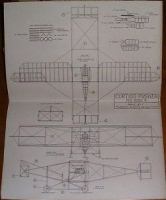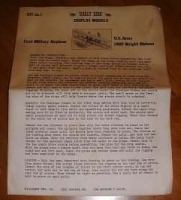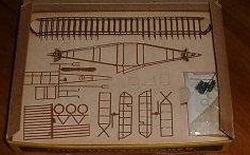Hillcrest 1/64 scale early biplanes
|
 |
Early days
Plastics are much older then many people believe, having been first
shown to the public at the Great International Exhibition in London in
1862. Rapid advancements soon put many different types of plastics into
the hands of the masses.
Among these was cellulose acetate, developed around the turn of the
century. Early use of this material was in photography as ‘Safety
Film’. It was not long before ways were found to produce this in
a powder that could be heated and molded into shapes using molding machines.
Thus came about the three different types of this plastic known as Bexoid,
Clarifoil and Tenite. The Eastman Kodak Company was a major producer of
Tenite products and in 1932 at their Tennessee facilities produced 8mm
amateur motion-picture film, projectors and different types of cameras
all made of a material called Eastman Tenite.
During World War II, model hobby kits were mostly made of cardboard
and small pieces of wood. I remember having as a child a large model of
the General Grant tank; it was probably around 1/16 scale. Whether it
was a kit or scratch built I don’t know. It was made of cardboard
and dowels using corrugated cardboard for tank tracks. I must have been
most impressed with it to be able to recall it almost sixty years later.
One of my distant relatives owned a hobby shop that was operated out of
the basement of his home. It was here that I became model hobby minded
and spent many pleasant hours every summer.
As the war grew to a close, Varney, a company that specialized in model
railroad items, produced three different models made of wood and Tenite
plastic. The dies were later sold to O-lin (later renamed Lindberg) which
retooled them into true all-plastic model kits. One was a PT boat, one
an LST, and the last a US Navy Fleet Submarine. Both the PT and the LST
in the original Varney kits used a wooden hull with Tenite detail parts.
The Fleet Submarine was made of solid Tenite Plastic with detailed parts.
Today, these kits are highly sought after.
Hillcrest
 This
brings us to the modern age of plastic modeling that signaled the death
knell for wood model kits. The Hillcrest Manufacturing Company of Los
Angeles, and later Hollywood, California under the name of Model Plastic
Products produced kits. Two such kits were the US Army 1909 Wright Biplane
and the 1910 Curtiss Pusher. These kits were designed to use tissue paper
to cover the wings. This was done in the same manner as it was done when
building a balsa stick model. Tissue paper was laid over the flying surface
and using model dope (manufactured by Testors) was glued and then wetted
to form a nice tight skin. This
brings us to the modern age of plastic modeling that signaled the death
knell for wood model kits. The Hillcrest Manufacturing Company of Los
Angeles, and later Hollywood, California under the name of Model Plastic
Products produced kits. Two such kits were the US Army 1909 Wright Biplane
and the 1910 Curtiss Pusher. These kits were designed to use tissue paper
to cover the wings. This was done in the same manner as it was done when
building a balsa stick model. Tissue paper was laid over the flying surface
and using model dope (manufactured by Testors) was glued and then wetted
to form a nice tight skin.
 Plastic
cement of the type used today would not bind Tenite so it was necessary
to use acetone (available in most drug or hardware stores) that would
dissolve the plastic and thus act as a bonding agent. Each model kit sold
came with a small packet of clear Tenite pellets. Mixed with acetone they
made a past-like solution, and applied to the parts and held for a few
minutes bonded the parts together allowing them to be assembled into a
three dimensional model. Plastic
cement of the type used today would not bind Tenite so it was necessary
to use acetone (available in most drug or hardware stores) that would
dissolve the plastic and thus act as a bonding agent. Each model kit sold
came with a small packet of clear Tenite pellets. Mixed with acetone they
made a past-like solution, and applied to the parts and held for a few
minutes bonded the parts together allowing them to be assembled into a
three dimensional model.
 What
is interesting to note is the lack of ‘flash’ on any parts or
part trees. There were no locating pins or picture step-by-step instructions.
It was up to you to assemble the model following the full size three-view
plan on the back of the instruction sheet. The instructions were typewritten. What
is interesting to note is the lack of ‘flash’ on any parts or
part trees. There were no locating pins or picture step-by-step instructions.
It was up to you to assemble the model following the full size three-view
plan on the back of the instruction sheet. The instructions were typewritten.

Today these models are true rarities.
 Thanks
for the look back to the *really* early days of plastic modeling, Don!
And readers, stand by for another special guest host next month with an
early and very desirable Monogram kit. As always, until next month, "Build
what YOU like, the way YOU want to", have fun and be sure to visit
Al's Place
while you're surfing the 'Net! Thanks
for the look back to the *really* early days of plastic modeling, Don!
And readers, stand by for another special guest host next month with an
early and very desirable Monogram kit. As always, until next month, "Build
what YOU like, the way YOU want to", have fun and be sure to visit
Al's Place
while you're surfing the 'Net!
Don advises that both of these kits are for sale to the best offer-
contact him using the email link above or by phone for details:
(586) 783-7966 (home landline)
(586) 484-9350 (cellphone with voice mail)
|
|
